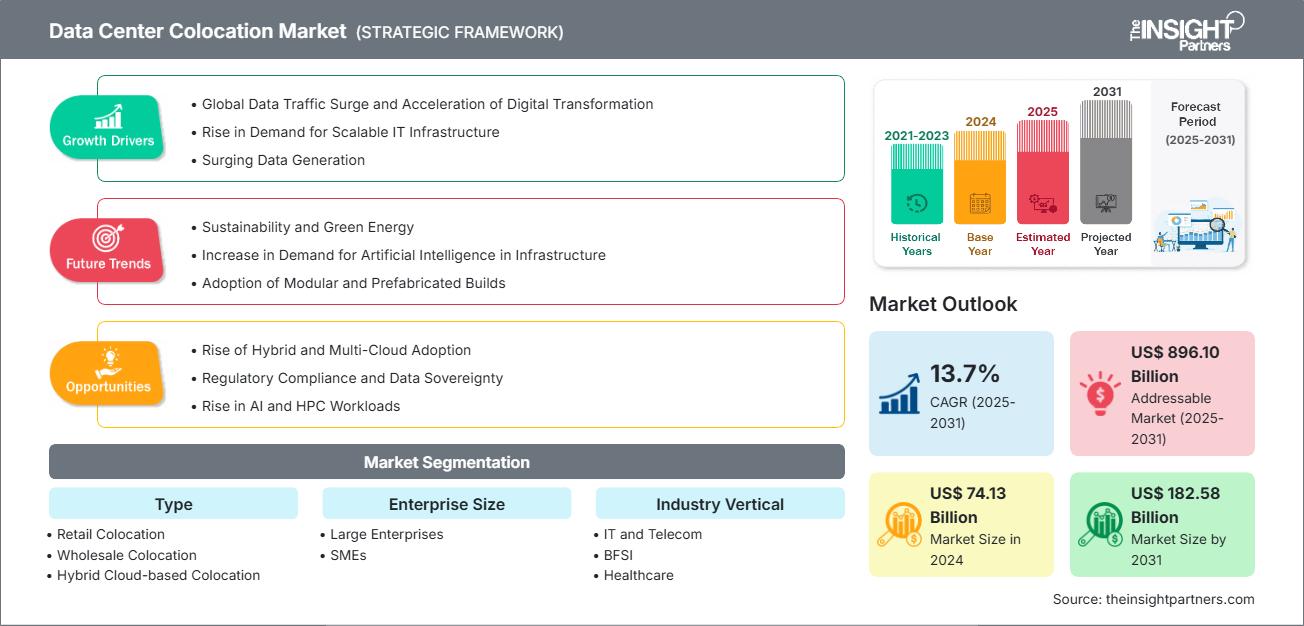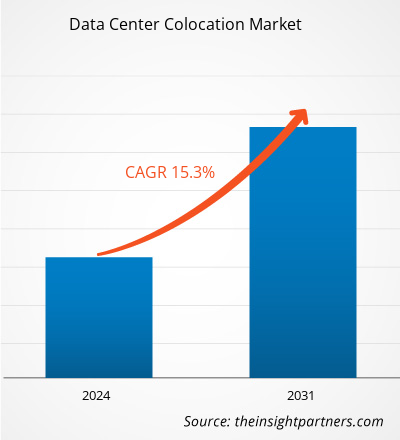2024 年数据中心托管市场规模价值 741.3 亿美元,预计到 2031 年将达到 1825.8 亿美元。预计 2025-2031 年期间该市场的复合年增长率为 13.7%。
数据中心托管市场分析
对可扩展IT基础设施、全球数据流量和数字化转型的需求日益增长,以及各行各业对数据中心的投资不断增加,是推动数据中心托管需求增长的关键因素。技术进步、混合云和多云的普及、以及监管合规性和数据主权的提升,预计将在预测期内为市场创造丰厚的利润。此外,对可持续性和绿色能源的高度关注,以及基础设施领域对人工智能需求的增长,预计将为市场带来未来的增长机会。
数据中心托管市场概览
数据中心托管市场涉及在共享设施内租用空间、电力和制冷设备,用于安置服务器和IT基础设施。本质上,它使企业能够拥有安全、可靠且可扩展的环境,而无需投入大量资金来构建和维护自己的数据中心。其优势包括成本效益、增强的安全性、通过冗余系统延长正常运行时间以及获得高速连接。此外,托管使企业能够专注于核心竞争力,同时外包物理基础设施管理。该市场的增长受到多种因素的驱动,例如数据的快速增长、云应用的不断增加、对灾难恢复解决方案的需求以及对靠近终端用户低延迟连接的需求。监管合规性和数据主权方面的担忧也促使企业选择提供经过认证且合规设施的托管服务提供商。此外,跨行业的数字化转型也刺激了需求,使得托管成为管理IT基础设施时实现可扩展性、灵活性和运营效率的战略选择。
您可以免费定制任何报告,包括本报告的部分内容、国家级分析、Excel 数据包,以及为初创企业和大学提供优惠和折扣
数据中心托管市场:战略洞察

-
获取此报告的顶级关键市场趋势。此免费样品将包括数据分析,从市场趋势到估计和预测。
数据中心托管市场驱动因素和机遇
市场驱动因素:
-
对可扩展 IT 基础设施的需求不断增长:
对可扩展IT基础设施的激增需求是全球数据中心托管市场不断扩张的根本驱动力。企业,尤其是金融服务、医疗保健、软件和电信等行业的企业,越来越多地转向托管服务提供商,而不是自行建设和运营数据中心。这种转变使企业能够快速扩展,避免大量的前期资本支出,并将固定成本转化为运营灵活性。这种增长的主要驱动力是人工智能、物联网、边缘计算和云原生服务带来的数字工作负载的增长,这些工作负载需要高密度、高弹性的基础设施。根据Uptime Institute的2023年容量趋势调查,64%的企业数据中心运营商正在扩展其容量,其中20%的企业以每年超过20%的速度增长。这表明对数据中心资源的内部需求强劲。此外,82%的企业预计对更高功率密度的需求将会增加。然而,超过三分之一的受访者表示,如果不进行升级,他们目前的设施将无法满足这一需求。这种情况为提供先进电力和冷却基础设施的托管服务提供商带来了巨大的机遇。
-
全球数据流量和数字化转型增长:
全球数据流量的快速增长和数字化转型的加速推动了对数据中心托管服务的需求。当今的企业正在应对由移动宽带、视频流、软件即服务 (SaaS)、物联网和企业应用程序驱动的海量数据,同时还要升级数字产品和服务以保持竞争力。根据国际电信联盟 (ITU) 发布的《2024 年事实与数据报告》,全球移动宽带流量在 2023 年超过 1 ZB,预计到 2024 年将达到 1.3 ZB;而固定宽带流量预计将在 2024 年达到 6 ZB,高于上一年的 5.1 ZB。海量数据的生成导致对数据中心及其互连网络的存储和处理需求空前高涨。流量增长率依然强劲,移动宽带流量年增长率约为 19.6%,固定宽带流量年增长率约为 15.2%。
市场机会:
-
混合云和多云采用:
混合云和多云的采用正在显著增长,这凸显了主机托管设施的明确作用:充当中立、安全且高度互联的枢纽,与超大规模云提供商进行互操作。企业需要与 AWS、Azure 和 Google 等多个云平台建立可靠的连接,而主机托管服务则能为其提供直接接入和高性能互连服务。此外,典型的客户会混合运行公有云和私有云工作负载——通常除了公有云部署外,还会将高达 81% 的基础设施保留在本地。 -
监管合规性和数据主权不断提高:
主机托管设施还能降低合规风险,简化监管报告流程,并增强灾难恢复能力,同时维护区域主权。在巴西、俄罗斯、印度和欧盟等新兴本地化法律的地区,企业越来越多地选择符合监管和运营治理要求的第三方运营商。随着全球监管复杂性的不断提升,主机托管服务提供商拥有独特的优势,能够提供企业所需的受管控、主权且可扩展的基础设施,使其成为数字时代合规性和业务连续性的战略赋能者。
数据中心托管市场报告细分分析
数据中心托管市场被划分为不同的细分市场,以便更清晰地了解其运作方式、增长潜力和最新趋势。以下是大多数行业报告中使用的标准细分方法:
按类型:
-
零售主机托管:
零售主机托管专为需要较小规模数据中心的企业、初创企业和政府机构而设计。通常,这指的是涉及少于 10 个主机托管机架或机柜的部署。零售主机托管空间可以由单个机架组成,这些机架可以并排放置,也可以分布在整个设施内,通过交叉连接进行互连,而不是封闭在专用机架中。提供商通常提供灵活的选择,包括 1U、2U、3U 或 4U 等增量的共享主机托管空间,以及专用的可锁定四分之一机架、半机架或全机架。客户还可以选择多个可锁定机架。服务通常按固定月费捆绑,具体取决于所包含的电量(例如,每电路或每千瓦)。例如,提供商可能会以固定价格提供配备 208V/20A 电源和 100 Mbps 混合互联网连接的全机架。 -
批发主机托管:
批发主机托管服务专为满足大型企业、服务提供商和政府机构对大量空间和电力的需求而设计。这些客户通常会获得专用基础设施,例如带锁的私人机柜、私人套间,甚至是专门为其需求设计的定制数据中心。批发主机托管的主要目标是将客户的IT基础设施与多租户设施中的其他基础设施隔离,从而增强安全性和控制力。与零售主机托管不同,批发主机托管的定价主要基于功耗。客户通常至少需要500千瓦的电力,具体功率因项目而异。提供商首先会确定客户的总可用电力需求。例如,如果客户需要500千瓦的电力来运行其异地IT环境,提供商将评估每个机架的功率密度。如果每个机架支持10千瓦,则将为客户分配50个机架。 -
基于混合云的主机托管:
基于混合云的数据中心托管兼具传统托管的优势,并能无缝集成公有云和私有云平台。这种模式允许企业将其关键基础设施托管在安全、高性能的设施中,同时将工作负载扩展到云端,从而增强可扩展性、灵活性和成本效益。托管服务提供商提供直接云连接、低延迟互连和托管服务,从而简化混合部署。
按企业规模:
-
中小企业:
随着中小企业扩大业务规模或进行全球扩张,主机托管服务能够提供现成的基础设施,从而加快进入市场的速度。它还能帮助中小企业更好地管理风险、提高正常运行时间,并将内部资源集中在核心业务创新上,而非数据中心管理上。 -
大型企业:
全球数据中心托管市场是大型企业追求数字化转型、混合云应用和全球可扩展性的关键推动力。随着企业寻求降低资本支出并提升基础设施敏捷性,托管为拥有和运营专有数据中心提供了一种战略替代方案。企业利用批发和零售托管模式,在高度安全、冗余且互联互通的设施中托管关键任务工作负载。这些环境可以直接访问云提供商、内容交付网络、金融交易所和网络运营商,从而促进高性能计算、实时数据交换和边缘部署。
垂直行业:
- 信息技术和电信
- 金融服务业
- 卫生保健
- 零售
- 其他的
按地域划分:
- 北美
- 欧洲
- 亚太地区
- 南美洲和中美洲
- 中东和非洲
北美数据中心托管市场是全球最大的市场,这得益于其强大的IT基础设施、广泛的云应用以及日益增长的数字化转型计划。美国和加拿大的需求旺盛,这主要得益于企业寻求可扩展、安全且经济高效的数据存储解决方案。超大规模云服务提供商和科技巨头不断扩展其托管设施,以支持人工智能、大数据和物联网工作负载。此外,该地区注重数据隐私和安全的监管环境也推动了对合规托管服务提供商的需求。
数据中心托管市场区域洞察
Insight Partners 的分析师已详尽阐述了预测期内影响数据中心托管市场的区域趋势和因素。本节还讨论了北美、欧洲、亚太地区、中东和非洲以及南美和中美洲的数据中心托管市场细分和地域分布。
数据中心托管市场报告范围
| 报告属性 | 细节 |
|---|---|
| 2024年的市场规模 | 741.3亿美元 |
| 2031年的市场规模 | 1825.8亿美元 |
| 全球复合年增长率(2025-2031) | 13.7% |
| 史料 | 2021-2023 |
| 预测期 | 2025-2031 |
| 涵盖的领域 |
按类型
|
| 覆盖地区和国家 |
北美
|
| 市场领导者和主要公司简介 |
|
数据中心托管市场参与者密度:了解其对业务动态的影响
数据中心托管市场正在快速增长,这得益于终端用户需求的不断增长,而这些需求的驱动因素包括消费者偏好的不断变化、技术进步以及对产品优势的认知度不断提高。随着需求的增长,企业正在扩展其产品线,不断创新以满足消费者需求,并利用新兴趋势,从而进一步推动市场增长。

- 获取数据中心托管市场顶级关键参与者概览
数据中心托管市场份额(按地区)分析
受蓬勃发展的数字经济、城镇化进程和互联网普及率不断提升的推动,亚太地区的数据中心托管市场呈现快速增长。由于企业云应用的不断增长以及电子商务、游戏和社交媒体行业的蓬勃发展,包括中国、印度、日本、澳大利亚和新加坡在内的众多国家都成为了重要的市场。该地区面临着电力供应和土地短缺等挑战,这刺激了对提供可扩展容量的高效托管服务的需求。政府推动智慧城市和数字基础设施建设的举措也刺激了市场的发展。此外,亚太地区的地缘政治复杂性和数据主权担忧促使企业在本地托管数据。边缘计算和5G部署的快速创新进一步加速了对支持延迟敏感型应用的托管服务的需求。
由于数字化转型、技术进步和产业扩张,各地区数据中心托管市场的增长情况有所不同。以下是各地区市场份额和趋势的总结:
1. 北美
-
市场份额:
在全球数据中心托管市场占有较大份额
-
关键驱动因素:
- 云服务的快速增长推动了对可扩展主机托管设施的需求
- 企业对 IT 基础设施进行现代化升级,增加了对安全、灵活的数据中心的需求
- 靠近最终用户需要更多分布式主机托管站点
-
趋势:
数据中心中人工智能和机器学习工作负载的集成度不断提高,以实现高级分析
2.欧洲
-
市场份额:
相当一部分 -
关键驱动因素:
- 推动对本地化、合规数据中心设施的需求
- 注重节能、绿色主机托管中心
- 超大规模数据中心的扩张增加了对主机托管容量的需求
-
趋势:
加大对可再生能源数据中心的投资以实现 ESG 目标
3. 亚太地区
-
市场份额:
增长最快的地区,市场份额逐年上升 -
关键驱动因素:
- 不断扩大的用户群推动了对数据托管和云服务的需求
- 大型数字基础设施项目需要强大的主机托管支持
- 数据流量的增加需要可扩展的主机托管
-
趋势:
模块化和集装箱化数据中心的出现,加快了部署速度
4.南美洲和中美洲
-
市场份额:
市场稳步增长 -
关键驱动因素:
- 云计算应用和数字经济的不断增长加速了对主机托管以支持数字服务的需求
- 政府投资信息通信技术基础设施,发展智慧城市和数字化转型
- 本地数据中心基础设施有限,推动外包给主机托管提供商
-
趋势:
加强地方政府与全球主机托管服务提供商之间的合作,以扩大基础设施
5.中东和非洲
-
市场份额:
尽管规模较小,但增长迅速 -
关键驱动因素:
- 互联网和移动接入的增加导致更高的数据流量和主机托管需求
- 经济增长和 IT 现代化推动企业进行外包,以提高成本效率和可扩展性
- 通过本地数据存储实现数据主权以遵守法规
-
趋势:
对混合云和多云策略的需求不断增长,影响着主机托管市场动态
数据中心托管市场参与者密度:了解其对业务动态的影响
市场密度高,竞争激烈:
由于 CoreSite Realty Corporation、CyrusOne Inc、Iron Mountain Inc、Digital Realty Trust Inc、Equinix Inc、Telehouse、NTT Data Corp、International Business Machines Corp、Rittal GmbH & Co KG 和 ATandT 等老牌企业的存在,竞争十分激烈。
这种激烈的竞争促使公司通过提供以下产品脱颖而出:
- 高性能基础设施和连接解决方案(例如低延迟互连、超大规模云平台的直接入口以及高带宽容量)
- 边缘和混合主机托管服务(支持分布式基础设施,实现集中式数据中心、边缘站点和多云环境之间的无缝集成)
- 可持续性和节能运营[绿色认证、可再生能源采购和先进的电源使用效率 (PUE) 指标]
- 以合规性为重点的安全框架(遵守 GDPR、HIPAA、ISO 27001 和 SOC 2 等全球监管标准)
- 可扩展和模块化基础设施设计(通过灵活的电力和空间配置支持快速的客户扩展)
- 用于运营优化的人工智能和自动化(预测性维护、自动化容量规划和智能监控系统)
机遇与战略举措
- 与云服务提供商、内容交付网络 (CDN) 和边缘计算供应商建立战略合作伙伴关系对于增强服务产品、推动低延迟交付以及支持混合和多云架构变得至关重要。
- 对边缘数据中心和微型主机托管设施的需求不断增长,正在开辟新的增长前沿,特别是在支持物联网、5G 部署以及各个垂直领域的延迟敏感应用方面。
- 在数字化程度不断提高、电子商务增长以及有利的监管环境的推动下,向北美、亚太和非洲的二线和三线城市进行地理扩张带来了强劲的增长机会。
- 增加对绿色数据中心和可持续发展计划的投资,使主机托管服务提供商能够吸引具有环保意识的企业、实现 ESG 目标并遵守更严格的能源效率法规。
- 先进的基础设施管理工具、数据中心基础设施管理 (DCIM) 和人工智能监控系统的集成正在提高运营效率、实现预测性维护并优化电力和冷却使用。
在数据中心托管市场运营的主要公司有:
- CoreSite Realty Corporation(美国)
- CyrusOne Inc(美国)
- Iron Mountain Inc(美国)
- Digital Realty Trust Inc(美国)
- Equinix公司(美国)
- Telehouse(美国)
- NTT数据公司(日本)
- 国际商业机器公司(美国)
- Rittal GmbH & Co KG(德国)
- AT&T(美国)
免责声明:以上列出的公司没有按照任何特定顺序排列。
研究过程中分析的其他公司:
- 戴尔公司
- 惠普企业发展有限公司
- 华为技术有限公司
- Vertiv集团公司
- 伊顿公司
- 施耐德电气
- 佳能科技有限公司
- PCX控股有限公司
- 台达电子股份有限公司
- 江森自控
- ABB有限公司
- 世图兹有限公司
- IE公司
- 边缘任务关键系统有限责任公司
- 中兴通讯股份有限公司
- 康普
- 亚马逊网络服务公司
数据中心托管市场新闻和最新发展
-
CyrusOne宣布与E.ON建立合作伙伴关系
2025 年 6 月,CyrusOne 和 E.ON 宣布,双方已达成首选合作伙伴协议,以设计和提供数据中心的本地发电解决方案。CyrusOne 是一家全球领先的数据中心所有者、开发商和运营商,专门在全球范围内提供先进的数字基础设施解决方案。E.ON 是欧洲最大的能源公司之一,也是能源网络、能源基础设施解决方案和能源销售领域的领导者。 -
Iron Mountain收购印度数据中心公司Webwerks
2025年4月,Iron Mountain宣布扩建其阿姆斯特丹数据中心园区。AMS-1将新增10MW的容量,使该数据中心更接近其60MW的最大建设规模。目前,该数据中心提供22.7MW的容量,占地面积17,000平方米(183,000平方英尺)。AMS-1位于阿姆斯特丹西部城市哈勒姆,占地23英亩。 -
Digital Realty 和 Bersama Digital Infrastructure Asia (BDIA) 宣布成立 Digital Realty Bersama
2025年3月,全球最大的云和运营商中立数据中心、主机托管和互联解决方案提供商Digital Realty(纽约证券交易所代码:DLR)与东南亚领先的数字基础设施平台Bersama Digital Infrastructure Asia (BDIA)宣布成立Digital Realty Bersama,这是一家双方各持股50%的合资企业,将在印尼各地开发和运营数据中心。该合资公司将PlatformDIGITAL拓展到充满活力的印尼市场,直接支持该国数字经济的加速和增长,而该经济的驱动力正是由该国年轻且精通数字技术的人口所驱动。
数据中心托管市场报告覆盖范围和交付成果
《数据中心托管市场规模和预测(2021-2031)》报告对以下领域进行了详细的市场分析:
- 数据中心托管市场规模以及涵盖范围内所有关键细分市场的全球、区域和国家层面的预测
- 数据中心托管市场趋势以及市场动态,例如驱动因素、限制因素和关键机遇
- 详细的 PEST 和 SWOT 分析
- 数据中心托管市场分析涵盖关键市场趋势、全球和区域框架、主要参与者、法规和最新市场发展
- 行业格局和竞争分析,涵盖市场集中度、热图分析、知名参与者以及数据中心托管市场的最新发展
- 详细的公司简介
- 历史分析(2 年)、基准年、预测(7 年)及复合年增长率
- PEST和SWOT分析
- 市场规模、价值/数量 - 全球、区域、国家
- 行业和竞争格局
- Excel 数据集
近期报告
相关报告
客户评价
购买理由
- 明智的决策
- 了解市场动态
- 竞争分析
- 客户洞察
- 市场预测
- 风险规避
- 战略规划
- 投资论证
- 识别新兴市场
- 优化营销策略
- 提升运营效率
- 顺应监管趋势






















 获取免费样品 - 数据中心托管市场
获取免费样品 - 数据中心托管市场